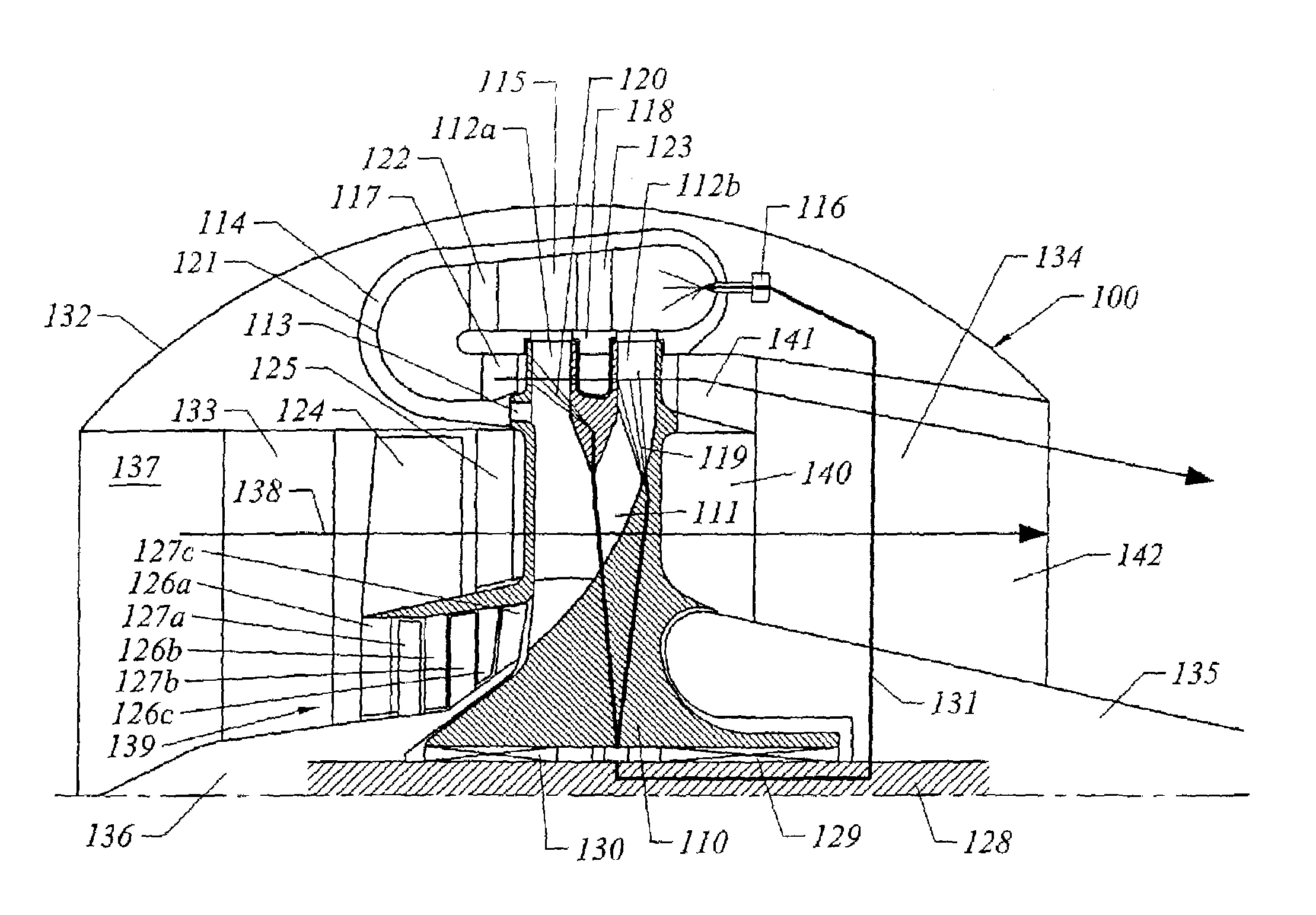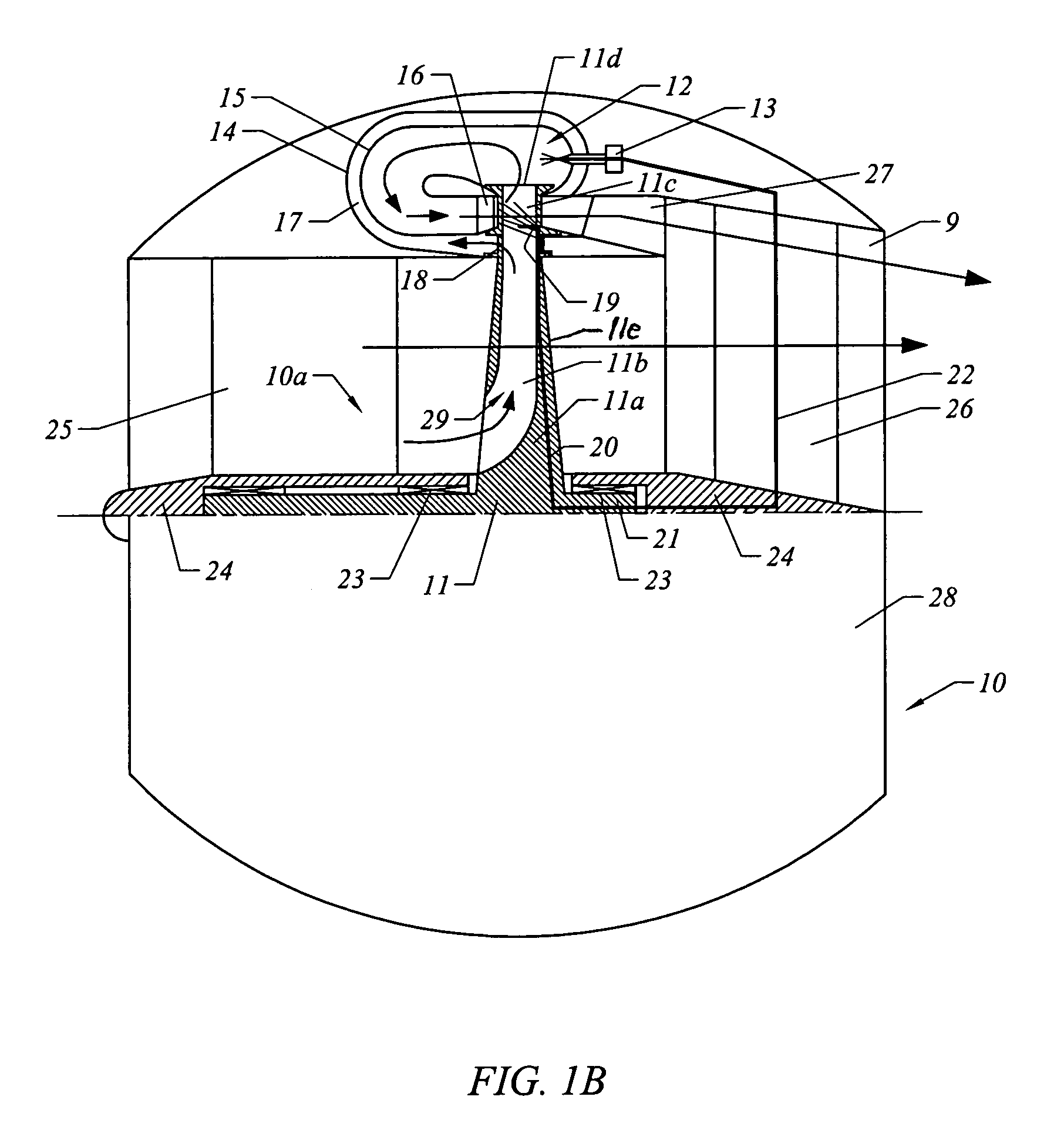Integrated bypass turbojet engines for air craft and other vehicles
a bypass turbojet and air craft technology, applied in the field of turbojet engines, can solve the problems of reducing the thermal efficiency of conventional turbojets, the complexity of modern turbojets has reached the maximum level, and the cost is beyond the affordability limit of the majority of the world, so as to achieve the effect of reducing complexity, weight, cost and maximizing the absolute thermal energy capacity and thermal efficiency
- Summary
- Abstract
- Description
- Claims
- Application Information
AI Technical Summary
Benefits of technology
Problems solved by technology
Method used
Image
Examples
first embodiment
[0085]In FIG. 8 there is depicted a fifth application of the turbojet engine 10 for a VTOL wing vehicle 80 in which the integrated turbo by-pass jet 81, described in the invention, is located in the front of the VTOL wing vehicle 80. The VTOL (vertical takeoff or landing) wing vehicle 80 has an intake channel 82, completely masked in the front profile of the fuselage for radar avoidance. Air-gas propulsion is diverted from a central channel 83 to a right channel 84 and a left channel 85 by the variable deflectors ports 86a and 86b. Transverse perpendicular openings 87a and 87b direct the selectively diverted airgas flow to each side of the wings for up or down discharge relative to the surface of the wing. The variably directed central exit 88 at the aircraft tail directs the main flow of air-gas and vector of jet propulsion axially in the main direction, or perpendicular to the face of the wing in either direction, up or down. The auxiliary wing panels 89a, 89b, 90a, 90b, 91a and 9...
embodiment 700
[0151]Referring to the embodiment in FIG. 32, the high altitude turbojet engine indicated generally by the number 750, is a derivative solution from the embodiment 700 of FIG. 31. The turbojet engine has a body 751, includes all the ram-air frontal components of the FIG. 31, but including a second ram-air turbine 752, having hollowed blades acting as a final isothermal centrifugal compressor 753 supplying compressed air through hollowed struts 754, conducting the cooled air to a central combustion chamber 755, surrounded by an air plenum 756, spaced from a combustion chamber liner 758, which is preferably made from ceramic.
[0152]The combusted jet rocket gases are controlled by a variable geometry exit nozzle 759, 760, optimizing a constant pressure ration for combustion at all speeds, which in turn conserves the maximum thermal efficiency during all regimes of flight.
[0153]The rocket gas jet 761 is finally mixed with by-pass air flow jet 762, forming the final combined propulsion je...
third embodiment
[0155]Referring to FIG. 33, the high altitude turbojet engine is designated generally by the reference numeral 800. The turbojet engine 800 has forward components that are the same as in the engine 750 with different internal aft components forming a central combustion system 802 for convertible turbine / rocket propulsion. In FIGS. 33 and 34 the ram-air turbine 752 and final isothermal centrifugal compressor 753 supply compressed air through first air passages 803 in the hollowed struts 754 and by-pass passage 805 around the struts 754.
[0156]As shown in greater detail in FIG. 34, the air passage 803 in the struts 754 divides into three channel 806, 807 and 808 formed by a concentric peripheral air plenum 810, a concentric internal air plenum 811, and an interposed perforated annular combustion chamber 812 concentric with the peripheral and internal air plenums 810 and 811. Fuel injectors 814 inject fuel into the annular combustion chamber 812 for generating combustion gases which pro...
PUM
 Login to View More
Login to View More Abstract
Description
Claims
Application Information
 Login to View More
Login to View More - R&D
- Intellectual Property
- Life Sciences
- Materials
- Tech Scout
- Unparalleled Data Quality
- Higher Quality Content
- 60% Fewer Hallucinations
Browse by: Latest US Patents, China's latest patents, Technical Efficacy Thesaurus, Application Domain, Technology Topic, Popular Technical Reports.
© 2025 PatSnap. All rights reserved.Legal|Privacy policy|Modern Slavery Act Transparency Statement|Sitemap|About US| Contact US: help@patsnap.com



